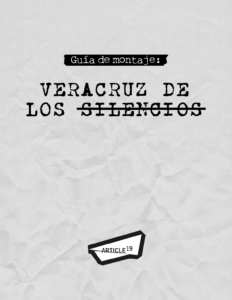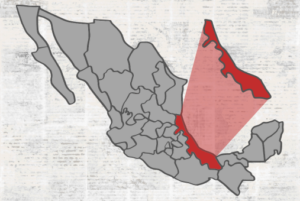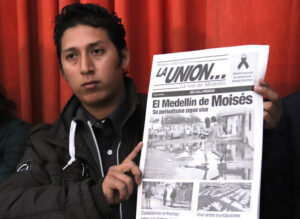“In Veracruz it was possible to kill so many journalists because doing so had no political cost,” independent journalist Paula Mónaco Felipe told LatAm Journalism Review (LJR).
 Veracruz is one of the most dangerous Mexican states to be a journalist and Mexico is considered one of the most dangerous countries in the world to practice journalism. In the six-year period from 2010 to 2016, at least 17 journalists were killed in Veracruz and another three were disappeared.
Veracruz is one of the most dangerous Mexican states to be a journalist and Mexico is considered one of the most dangerous countries in the world to practice journalism. In the six-year period from 2010 to 2016, at least 17 journalists were killed in Veracruz and another three were disappeared.
“We decided to look back and study that period of time to answer the question: why are journalists killed?” said Monaco, who was in charge of reporting, writing and editing the recent investigation, “Veracruz de los silencios” (Veracruz of silences).
According to the investigative team, in the 20 cases studied, more than 60 people have been identified by the authorities as possibly responsible, however, only 29 people have been investigated, charged or (some) arrested.
The lethal violence against journalists in Veracruz and its consequences are known worldwide, but Article 19's investigation presents new findings.
The first thing that Mónaco and María De Vecchi, an official from the organization's Truth and Memory Program, told LJR is that censorship, fear and silence persist for journalists in Veracruz and the families of the murdered journalists. They also said that there is still almost no access to official information from the time related to these cases.
One of the great contributions of the investigation is the macro-criminal approach, led by specialist María Eloisa Quintero, who is a lawyer, investigator and international consultant on macro-criminality. A macro-criminal approach refers to criminal events that take place on a large scale, or international crimes that incorporate institutional policies and practices.
The report found that the majority of the bodies of the murdered journalists were left on public roads (only two bodies were found in graves), “a message of terror to generate silence,” De Vecchi said.
“We found that the majority of the murdered journalists were victims of torture. They spent a period of time in the hands of their captors who gathered information through torture, in some cases they had taken away their work tools,” Mónaco said. “The State had minimized the fact that they were journalists, but these data help to understand that they may have been murdered for their journalistic work.”
In a scenario of impunity like that of Veracruz, the investigators highlighted that the work of the murdered and disappeared journalists was erased: “Most of the pages where they published are taken down. In the companies where they worked, nothing has been saved. In the state newspaper archive they told us that they had thrown away all the newspapers from that time, and the families have stopped keeping the archive [of their reporting] for fear of what it might imply,” Mónaco explained. “It's as if that period had not existed.”
A journalistic investigation between silence
 The investigation into Veracruz was carried out between June 2022 and October 2023. The investigative team made four trips to Veracruz, interviewing 33 journalists, relatives of victims, former officials and experts on violence in Veracruz and Mexico from 2010 to 2016.
The investigation into Veracruz was carried out between June 2022 and October 2023. The investigative team made four trips to Veracruz, interviewing 33 journalists, relatives of victims, former officials and experts on violence in Veracruz and Mexico from 2010 to 2016.
They also analyzed more than 350 open sources (that were open to public access and use) to understand the authorities' discourse before and after the murders and disappearances of the journalists. They made 288 requests for information to federal, state and local bodies. They obtained 86 documents from the Public Registry of Commerce and 20 from other official registers and records.
Mónaco said that they asked the prosecutor's office and various entities of the government of Veracruz for official statements and bulletins about the cases, access to files, news on lines of investigations, agreements and advertising contracts, and almost all of their requests were denied. “They told us ‘we don’t have that information, that no longer exists,” she said.
Furthermore, the journalist acknowledged that “it was very difficult for people to want to speak, to put their face and voice in the interviews. That's why we call it ‘Veracruz of Silences.’"
The consequences of media concentration and conflict of interest in Veracruz
According to the authors of the report, a fact that is not minor, but little discussed in Mexico, is the role of the media ("companies,” as they called them) in the murders and disappearances of journalists.
“In the first years of murders against the press in Mexico, people thought that drug traffickers killed them. Then it was learned that the State also killed them, between 40% and 65% of attacks [murders, threats, abductions, among others] against the press in Mexico have been perpetrated by agents of the State,” Mónaco said. “These are the two elements analyzed so far.”
To make this panorama more complex, during the investigation they found two conditions through which they say the media allow and facilitate violence against the press: media concentration and conflicts of interest on the part of media owners.
The investigative team revealed that during the six-year period analyzed in the state of Veracruz, there were 108 print media outlets, and that 19 of the 20 journalists murdered and disappeared in that period worked in one of these media (not radio or television).
They also found that three corporate groups edited 24 of the most influential print media in the state.
“The media concentrated in a few families that also belong to the political class is a murky plot that allows violence against journalists,” Monaco said.
“These companies had a fairly opaque operation, the majority were public limited companies with variable capital. They had actions that were not very transparent with regard to tax matters, and only one of them had the purpose of media publishing,” Mónaco said. And she added that the rest were authorized to sell air conditioners, televisions, refrigerators and carry out construction, but not to publish media.
“The families that owned these media outlets participated in political life and held political positions in Veracruz, which is why they allocated public funds to their own companies,” Mónaco explained in an interview.
“These are the companies that pay journalists $200 per month to cover dangerous topics while they receive millions of pesos. That conditioned the editorial line and the journalists did not know which side they were playing for,” Mónaco said.
The legacy of a journalist murdered in Veracruz

Jorge Sánchez continues to publish his father's newspaper. (Courtesy)
Although there aren’t many records of the work of journalists murdered and disappeared from 2010 to 2016 in Veracruz, Jorge Sánchez keeps his father's legacy alive.
Moisés Sánchez was a prominent journalist in Medellín de Bravo, a city located in the state of Veracruz. His body was found Jan. 24, 2015, after he was abducted from his home and disappeared. From the beginning there were suspicions – including from authorities – that the then-mayor of the city, Omar Cruz Reyes, and members of the municipal police could be involved. However, Cruz denied this and no one has been charged.
Jorge Sánchez's fight not only involves demanding justice for the murder of his father, but also continuing to edit the independent media outlet that Moisés founded: La Unión Veracruz. Sánchez learned the trade by practicing with his father from the age of 13, then he studied computer science.
“My father pointed out to me that the government does nothing unless there is social pressure, and to exert pressure there are media,” Sánchez told LJR to explain one of the reasons why he continues with the media outlet.
Sánchez said that his father began practicing journalism in the 1980s, and that he always worked independently. He was in charge of the entire process: conducting the interviews, gathering information, writing, typesetting, printing and distributing the copies. Thus, according to Sánchez, he became a prominent journalist in the area.
Currently, Sánchez said that in Veracruz, “oftentimes someone uploads the news that a person was murdered or abducted and then they speak to you so that you take down the information, that this should not be covered, that it was not an abduction. Narco-politics has very clearly identified what they want to see come out and what they don't."
In his case, he added that he decided to leave the “nota roja [reports on crime] because it is very difficult to function in that category.” Furthermore, he said “information is controlled a lot and if a journalist is murdered, the message immediately is that he must have been doing something, that he was on the wrong track.”
Some measures to mitigate violence against the press in Mexico, according to investigators
“[In Mexico,] no one is shocked and no one knows how many journalists have been killed,” Monaco said.
During the interview with LJR, the investigators shared a series of measures that in their opinion help to mitigate violence against journalists in Veracruz and Mexico more generally.
For example, limiting the amount of official advertising, which they say until now is given unequally and due to political decisions.
“When Duarte's government ended, at least 16 media outlets closed; at that level it was economic dependence,” Mónaco said.
Javier Duarte de Ochoa was governor of Veracruz during the six year period studied. He was convicted of criminal association and money laundering and is currently in prison. He was also accused of the crime of forced disappearance.
In addition, Mónaco said that it is necessary to prevent the conflicts of interest between the political and business sectors with the media; to protect the work of murdered journalists to facilitate the investigation of the crime and build memory; to facilitate access to files and legal representation for the families of murdered journalists; to investigate the cases beyond the material authors and hold the intellectual authors responsible; and to improve the protection mechanism for journalists in Mexico, which is not sufficient for the level of violence they are exposed to through their work.
For the investigators, it is also important to improve the working conditions of journalists and demand that the media respond to their murders and disappearances. Otherwise, what Monaco said and what was published about the murder of Gregorio Jiménez, a Veracruz journalist abducted by an armed group on Feb. 5, 2014 and later found dead in a grave, happens: “I went to Gregorio Jiménez's funeral and the media outlet where he worked didn’t even want to pay for the coffin.”